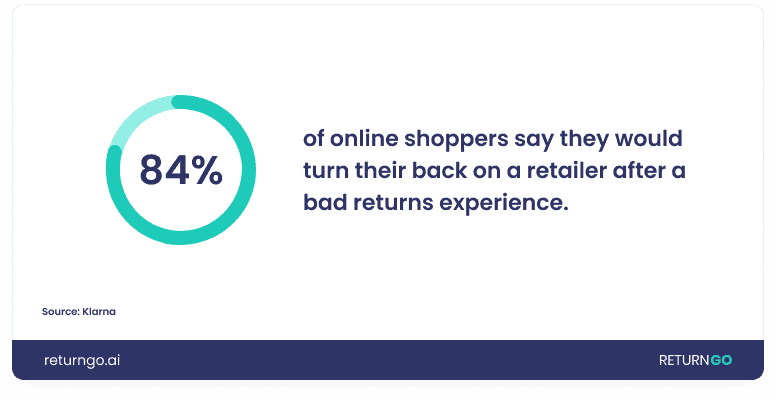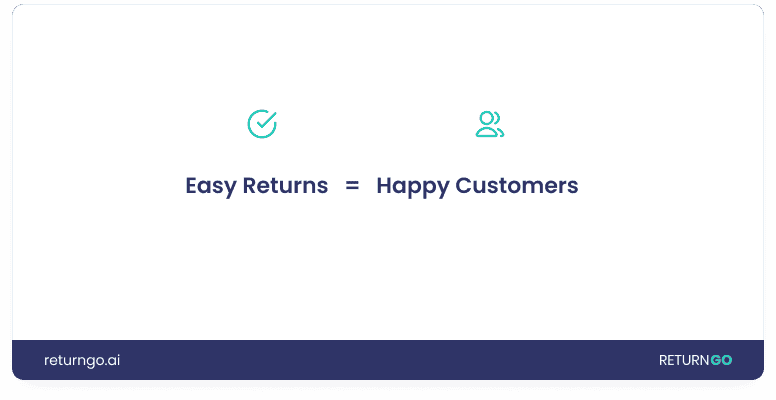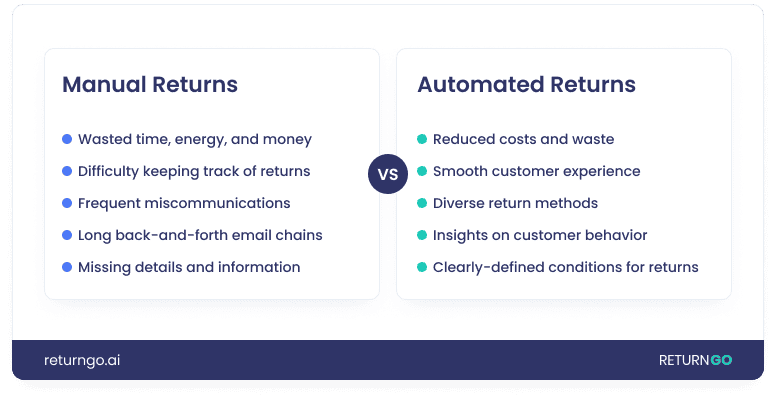The customer journey doesn’t end at checkout. In a way, it’s just the beginning. The post-purchase experience is a crucial step that can make or break your customer relationships, and returns are at the core of the post-purchase experience.
Why returns matter
An efficient, customer-friendly returns process demonstrates your brand’s commitment to delivering an exceptional experience, even when things don’t go as planned. Returns also provide valuable insights into customer needs and preferences, enabling you to improve your processes and products.
Let’s take a look at the ways returns make a difference in the post-purchase experience.
1. Understanding customer needs and preferences
Every return tells a story, and by carefully analyzing your returns data, you can gain valuable insights into customer needs and preferences. When customers choose to return a product, they’re essentially providing feedback on their shopping experience.
Analyzing your return data can give you a deeper understanding of why customers are returning products. Are there common themes such as sizing issues, quality concerns, or misleading product descriptions? Understanding the root causes of returns allows you to address underlying issues and make necessary improvements to your product offerings.
For example, let’s say you notice a pattern of returns related to sizing issues. In that case, you may need to reassess your sizing charts, provide clearer size guides, or offer more detailed product descriptions to help customers make informed purchasing decisions.
By actively listening to your customers through their return behavior, you can adapt and tailor your offerings to better meet their needs and preferences.
2. Building trust and confidence
Think about it this way: a complicated or slow returns process can be incredibly frustrating. Long wait times for refunds, unclear policies, and hidden fees can leave a bad taste in a customer’s mouth and damage their trust in your brand. Imagine waiting weeks for a refund after a disappointing purchase – it’s not a feeling that inspires confidence.

In fact, 84% of online shoppers say they would turn their back on a retailer after a bad returns experience.
On the other hand, a transparent and efficient returns process can build trust and confidence in your brand. When customers know exactly what to expect, from clear return windows to easy-to-follow processes, they’ll feel more confident about their purchase decisions and be more likely to buy from you again.
By offering hassle-free returns, you demonstrate your commitment to customer satisfaction and establish your brand as reliable and trustworthy.
To use returns to build customer trust and confidence, use a shipping solution like Sendcloud, integrated with your returns management system, to provide easy pre-paid return shipping labels and provide real-time updates on the status of their return. This can remove friction, alleviate anxiety, and demonstrate your commitment to customer satisfaction.
A positive returns experience can even turn a potentially negative situation into a positive one. Handling returns smoothly and efficiently shows customers that you value their business, leading to increased customer loyalty, as they’re more likely to return for future purchases knowing they can easily return an item if needed.
3. Enhancing the customer experience
Returns are a critical touchpoint in the customer journey and can have a big impact on the overall customer experience. A smooth and streamlined returns process can turn a potentially negative experience into a positive one, leaving customers feeling valued and satisfied.
Implement intuitive self-service returns backed by automated processing, transparent post-purchase communication, and flexible return options. 81% of customers say they want more self-service options, so a frictionless returns experience can delight customers by making their lives easier.
When customers feel informed, empowered, and valued throughout the returns process, you affect their overall post-purchase experience. What may have started out as a delivery issue or misfitted item is turned into a moment where you show your expertise and commitment to customers – providing memorable experiences that can help you win customers for life.

4. Optimizing inventory management
Returns data is an invaluable resource for refining inventory strategies. By examining the reasons and patterns behind returns, you can discern which products excel and which require adjustments—such as addressing frequent returns due to sizing errors, quality concerns, or inaccurate product descriptions.
With these insights, you can optimize inventory levels and refine your purchasing strategies. For instance, you might adjust stock to favor items with lower return rates or enhance quality control to mitigate recurring issues.
Effectively integrating your inventory management with returns data ensures you maintain the optimal stock levels, meeting customer expectations and reducing future returns.
5. Streamlining operations and reducing costs
While a positive returns experience is crucial for customer satisfaction, the benefits of a well-managed returns process extend well beyond the customer-facing aspects. Efficient returns can also streamline your internal operations and reduce your costs significantly.
Automating your return workflows through tools like ReturnGO can help reduce many manual, time-consuming tasks for your team. Let customers initiate returns and exchanges themselves, with just a few clicks, instead of tying up your customer support agents with endless requests and paperwork.
Key benefits of automating returns
Some of the effects of automating your returns can include:
- Reduced processing time: Automation is key to streamlining returns. Instead of manually handling each return, verifying details, and issuing refunds, automation takes over these tasks. This frees up your staff’s time and resources for other important areas of your business.
- Inventory optimization: Automating the inspection and processing of returned items allows you to quickly decide if they can be restocked and sold again. This reduces the need for markdowns or clearance sales, increasing the revenue potential from your inventory.
- Improved data-driven decisions: Data from returns offers crucial insights into product performance and customer preferences. By analyzing why customers return items, you can pinpoint improvements for your product designs, sizing guides, or descriptions. This data also helps you target your marketing campaigns more effectively and decrease future returns.
- Reduced warehouse costs: A lot of returns can clutter your warehouse with unsorted items. Automation helps manage this by ensuring that returns are quickly processed, sorted, and either restocked or disposed of efficiently. This reduces wasted space and cuts down on the costs of managing your warehouse.
- Fraud prevention: A strong returns management system helps identify and prevent fraud. By verifying returns and tracking return history, you can prevent return fraud and protect your business from potential losses
The post-purchase process isn’t just about customer satisfaction; it’s about running a smarter and more efficient business. Streamline your operations, optimize inventory, and make more data-driven decisions to significantly reduce costs and improve your bottom line.

Streamline your post-purchase process
Handling returns well is key to keeping your customers happy and turning challenges into opportunities for your business.
If your main challenge is managing a lot of returns, ReturnGO is just what you need. It’s designed to take the hassle out of returns, automating everything from processing requests to issuing refunds. It’s great for businesses that see a lot of back-and-forth on products and need a reliable way to handle it all.
Meanwhile, Sendcloud might be exactly what you’re looking for to cover all aspects of shipping. It’s an all-in-one platform that helps manage your entire shipping workflow. This could be a real game-changer, especially if you’re looking to streamline everything from sending out orders to handling return shipments all in one place.
Using ReturnGO and Sendcloud’s seamless integration solves all those challenges at once, empowering you to streamline your processes and easily keep everything in sync.
The right tools can transform a good customer experience into a great one, and that can make all the difference in building a loyal customer base. So, take a moment to assess your needs and make a choice that will propel your business forward.
Author
Rebecca Fox is ReturnGO’s Product Marketing Manager. She is passionate about educating eCommerce business owners on how they can streamline their post-purchase process. Using her experience and industry expertise, Rebecca is committed to helping businesses thrive in the ever-changing world of eCommerce.









